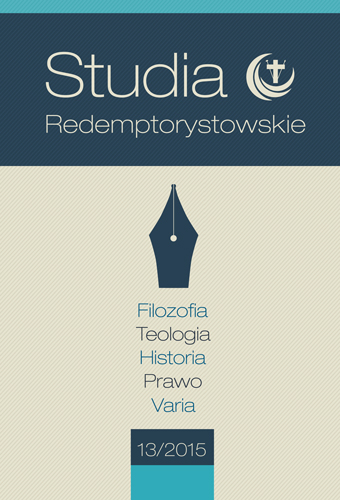Maryjne elementy wystroju kościoła karmelitów bosych pw. Niepokalanego Poczęcia w Krakowie
Marian elements of the decor of the Carmelite’s Immaculate Conception church in Krakow
Author(s): Szczepan T. PraśkiewiczSubject(s): Fine Arts / Performing Arts, Architecture, Theology and Religion
Published by: Warszawska Prowincja Redemptorystów
Keywords: discalced carmelite; marian spirituality; church of Immaculate Conception in Krakow; the decor
Summary/Abstract: We start with the fact that since the dawn of its history, the CarmeliteOrder has been the Virgin Mary’s Order and defender of the dogma of theImmaculate Conception. This article points out that when the Discalced Carmelitesarrived in Poland in 1605 and settled in Krakow, their first churchon Polish soil was dedicated to the Immaculate Conception. The order wasforced to leave the royal city due to the Austrian occupancy when their monasterywas converted into a hospital, and the monastery church into a hospitalchurch (historical objects from that time still exist). In 1909, the Order decidedto return to Krakow and to build there – not far from the present building,a new church and monastery, to both of which was given the same title, ImmaculateConception.This article describes the design of that church, in which elements of theVirgin Mary dominate, from the facade through to the nave and in the presbytery(with a reproduction masterpiece by an unknown painter which measuresmore than 5m in height of The Immaculate Virgin by BartholomewMurillo at the main altar), stained glass windows and the side chapels of OurLady of Sorrows and the Madonna of Ostra Brama.The Marian message of the church interior is highlighted for us throughthe eyes of Mary – in particular the mystery of her Immaculate Conception,as Virgo Pariturans (the Virgin having to give birth) which Elijah, the spiritualfather of Carmel, prophetically contemplated in the cloud (cf. 1 Kings 18:41–45). Also depicted is the mystery of the Incarnation and Divine Motherhood,as a example of the wonderful collaboration with the Lord (Socia Redemptoris)in the work of man’s redemption, encompassing her Son dyingon the cross; as the Virgin’s “fiat”, “magnificat” and “stabat”, which is a sign ofsure hope and comfort for all those who wish to journey along the path to theheavenly home.
Journal: Studia Redemptorystowskie
- Issue Year: 2015
- Issue No: 13
- Page Range: 295-305
- Page Count: 11
- Language: Polish

